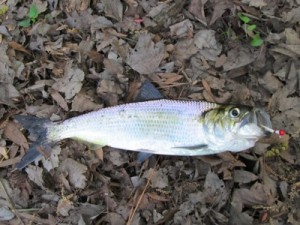In streams and creeks along the Mid Atlantic coast, hickory shad runs are a ritual of spring. Hickory shad, and their larger cousins, American shad are highly sought after by fly fishermen, ultralight spinning enthusiasts, and other anglers. Both hickory and American shad are hard fighters, known for their leaping ability and searing runs.
Hickory shad are anadromous; they live as adults in coastal estuaries or the open ocean, but return to their natal streams to spawn. After they spawn, hickory shad return to saltwater until the following spring.
To the beginning angler, shad fishing may appear intimidating but once the fish are located, many people are hooked. Before the season starts, it is usually a good idea to talk to local anglers about where shad have been caught in past seasons.
On a given stretch of river, creek, or stream, hickory shad may be abundant in some areas and non-existent just a short distance away. This may be due to a number of factors, most of which are easy to recognize.
Hickory shad prefer areas where moderate to fast currents exist with rocky, gravel, or hard sand bottoms. They often congregate near structures such as large rocks, fallen trees, or sharp bends where relatively slow moving waters meet contrast with stronger flows.
When scouting an area for the presence of hickory shad, anglers watch for movement along the water’s surface. At times, hickory shad are unmistakable as they leap into the air while feeding. Other signs may be much less obvious, even going un-noticed by casual observers.
Even a dime-sized swirl can sometimes indicate fish. In addition to sight, hickory shad can sometimes be heard as their body movements near the surface create a slapping or swishing sound.
Once hickory shad have been located, habitat often presents a considerable challenge for anglers. If fishing from a boat, maneuverability can be an issue as prime hickory shad stretches are often a maze of downed trees, hidden obstructions, low hanging branches and other hazards. When fishing from shore, anglers often face the same obstacles, along with ticks, chiggers, snakes, and other menaces.
When conditions are good, the fishing can be incredible for short periods. The nature of the fishery demands a variety of skills. Accurate casts are important, as is the ability to work quickly. Overhanging limbs, submerged obstructions, and other hazards all take their toll on equipment.
Fortunately, hickory shad require only basic tackle. Most anglers use ultralight spinning outfits and a variety of small jigs. By far the most popular choice is the shad dart. This traditional lure is simple, inexpensive, and effective. When casting to hickory shad, anglers fish shad darts as singles or in tandem. Other effective lures include panfish jigs, small spoons, or other flashy lures.
Fly fishermen often follow a similar strategy, using lightweight outfits for catching hickory shad. Small, flashy streamers are popular for catching shad, with white, silver and blue being the dominant colors on most rivers.
Although the possession of shad is prohibited in several states, catch and release fishing is generally allowed.
Related Information
